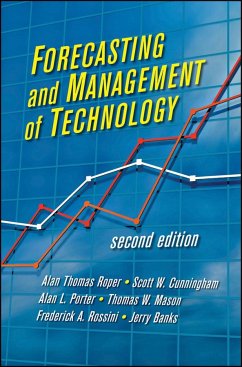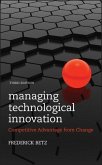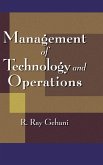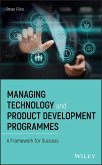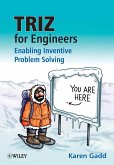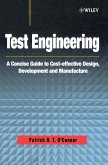Alan L Porter, Scott W Cunningham, Jerry Banks, A Thomas Roper, Thomas W Mason, Frederick A Rossini
Forecasting and Management of Technology
Alan L Porter, Scott W Cunningham, Jerry Banks, A Thomas Roper, Thomas W Mason, Frederick A Rossini
Forecasting and Management of Technology
- Gebundenes Buch
- Merkliste
- Auf die Merkliste
- Bewerten Bewerten
- Teilen
- Produkt teilen
- Produkterinnerung
- Produkterinnerung
An update to a respected text in the growing field of technology management Building on the familiarity and esteem of its predecessor, this revised Second Edition of Forecasting and Management of Technology discusses general issues that are related to forecasting and management, an area that has grown in importance and sophistication over the past few decades. It includes expanded coverage of evolving methodologies through the use of numerous exhibits, case studies, and exercises to show how to apply these methods to significant issues in managing technological development. This new Second…mehr
Andere Kunden interessierten sich auch für
![Managing Technological Innovation Managing Technological Innovation]() Frederick BetzManaging Technological Innovation185,99 €
Frederick BetzManaging Technological Innovation185,99 €![Management of Technology and Operations Management of Technology and Operations]() R Ray GehaniManagement of Technology and Operations183,99 €
R Ray GehaniManagement of Technology and Operations183,99 €![Managing Technology and Product Development Programmes Managing Technology and Product Development Programmes]() Peter FlinnManaging Technology and Product Development Programmes133,99 €
Peter FlinnManaging Technology and Product Development Programmes133,99 €![Triz for Engineers: Enabling Inventive Problem Solving Triz for Engineers: Enabling Inventive Problem Solving]() Karen GaddTriz for Engineers: Enabling Inventive Problem Solving80,99 €
Karen GaddTriz for Engineers: Enabling Inventive Problem Solving80,99 €![Design, Modeling and Reliability in Rotating Machinery Design, Modeling and Reliability in Rotating Machinery]() Design, Modeling and Reliability in Rotating Machinery244,99 €
Design, Modeling and Reliability in Rotating Machinery244,99 €![Test Engineering Test Engineering]() Patrick O'ConnorTest Engineering136,99 €
Patrick O'ConnorTest Engineering136,99 €![Maintenance, Reliability and Troubleshooting in Rotating Machinery Maintenance, Reliability and Troubleshooting in Rotating Machinery]() Maintenance, Reliability and Troubleshooting in Rotating Machinery203,99 €
Maintenance, Reliability and Troubleshooting in Rotating Machinery203,99 €-
-
-
An update to a respected text in the growing field of technology management Building on the familiarity and esteem of its predecessor, this revised Second Edition of Forecasting and Management of Technology discusses general issues that are related to forecasting and management, an area that has grown in importance and sophistication over the past few decades. It includes expanded coverage of evolving methodologies through the use of numerous exhibits, case studies, and exercises to show how to apply these methods to significant issues in managing technological development. This new Second Edition: * Delivers a thorough overview of the growing field of technology management for students and professionals * Updates and strengthens the forecasting tools and methodologies that were introduced in the first edition, emphasizing a more integrated approach to making forecasts, and sharpens the focus on the role of technology in formulating a business strategy * Includes five case studies from different industries to demonstrate how these tools can be applied in real-world situations Consistently practical in its coverage, Forecasting and Management of Technology, Second Edition delivers a detailed study of forecasting tools and analyses to assist companies in adapting to new technologies that are constantly expanding, and helps them discover the necessity and advantages of integrating technology into their organizational strategies.
Hinweis: Dieser Artikel kann nur an eine deutsche Lieferadresse ausgeliefert werden.
Hinweis: Dieser Artikel kann nur an eine deutsche Lieferadresse ausgeliefert werden.
Produktdetails
- Produktdetails
- Verlag: John Wiley & Sons / Wiley
- 2nd edition
- Seitenzahl: 352
- Erscheinungstermin: 12. Juli 2011
- Englisch
- Abmessung: 249mm x 164mm x 25mm
- Gewicht: 615g
- ISBN-13: 9780470440902
- ISBN-10: 0470440902
- Artikelnr.: 33081738
- Herstellerkennzeichnung
- Libri GmbH
- Europaallee 1
- 36244 Bad Hersfeld
- gpsr@libri.de
- Verlag: John Wiley & Sons / Wiley
- 2nd edition
- Seitenzahl: 352
- Erscheinungstermin: 12. Juli 2011
- Englisch
- Abmessung: 249mm x 164mm x 25mm
- Gewicht: 615g
- ISBN-13: 9780470440902
- ISBN-10: 0470440902
- Artikelnr.: 33081738
- Herstellerkennzeichnung
- Libri GmbH
- Europaallee 1
- 36244 Bad Hersfeld
- gpsr@libri.de
ALAN THOMAS ROPER (retired) was a professor at Rose-Hulman Institute of Technology in Terre Haute, Indiana. He is the past editor of the journal Impact Assessment and Project Appraisal and the past director of the Center for Technology and Policy Studies at Rose-Hulman. SCOTT W. CUNNINGHAM obtained a MSc in public policy from the Georgia Institute of Technology and a DPhil in science, technology, and innovation policy from the University of Sussex. He is currently Assistant Professor of Policy Analysis in the Department of Technology, Policy, and Management at Delft University of Technology. ALAN L. PORTER has led development of "technology opportunity analysis" and mining electronic, bibliographic data sources to generate intelligence on emerging technologies. He holds an MA in psychology and a PhD in engineering psychology, both from UCLA. He is currently Director of Research and Development for Search Technology, Inc., in Norcross, Georgia. THOMAS W. MASON was the founding head of the Engineering Management Department (www.rose-hulman.edu/msem). While on a three-year leave from Rose-Hulman, he served as CFO and CEO of a 140-person network management systems business. FREDERICK A. ROSSINI (retired) is a former provost at George Mason University in Fairfax, Virginia. JERRY BANKS is Professor Emeritus, Department of Industrial and Systems Engineering, Georgia Institute of Technology in Atlanta, Georgia.
Acknowledgments xv
1 Introduction 1
1.1 About This Book 1
1.2 Technology and Society 2
1.2.1 Social Change 3
1.2.2 Technological Change 4
1.3 Management and the Future 6
1.3.1 Management and Innovation Processes 7
1.3.2 The Role of Technology Forecasting 9
1.3.3 The Importance of Technology Forecasting 10
1.3.4 The Role of Social Forecasting 12
1.4 Conclusions 13
References 13
2 Technology Forecasting 15
2.1 What Is Technology Forecasting? 15
2.1.1 Models of Technology Growth and Diffusion 17
2.1.2 Technology Forecasting in Context 18
2.1.3 What Makes a Forecast Good? 20
2.1.4 Common Errors in Forecasting Technology 21
2.2 Methodological Foundations 23
2.2.1 The Technology Delivery System 24
2.2.2 Inquiring Systems 28
2.3 Technology Forecasting Methods 31
2.3.1 Overview of the Most Frequently Used Forecasting Methods 33
2.3.2 Method Selection 37
2.4 Conclusion 37
References 38
3 Managing the Forecasting Project 40
3.1 Information Needs of the Forecasting Project 40
3.1.1 The Technology Manager's Needs 42
3.1.2 The Forecast Manager's Needs 43
3.1.3 Information about Team Members 44
3.2 Planning the Technology Forecast 46
3.3 Team Organization, Management, and Communications 47
3.3.1 Organizing and Managing the Technology Forecast 50
3.3.2 Communications 54
3.3.3 Summary Conclusions about Project Management and Organization 55
3.4 Success: The Right Information at the Right Time 56
3.5 Project Scheduling 57
3.5.1 Program Evaluation and Review Technique (PERT) 58
3.5.2 Gantt Chart 60
3.5.3 Project Accountability Chart (PAC) 60
3.5.4 Project Scheduling Software 61
3.6 Conclusions 62
References 62
4 Exploring 65
4.1 Establishing the Context-the TDS 65
4.1.1 Societal and Institutional Contexts 66
4.1.2 Technology Context 67
4.1.3 Stakeholders 68
4.1.4 Understanding the TDS 69
4.1.5 An Example TDS Model 70
4.2 Monitoring 72
4.2.1 Why Monitor? 74
4.2.2 Who Should Monitor? 75
4.2.3 Monitoring Strategy 76
4.2.4 Monitoring Focused on Management of Technology Issues 79
4.2.5 Monitoring Focused on the Stage of the Technology Development 81
4.3 The Stimulation of Creativity 81
4.3.1 Five Elements of Creativity 81
4.3.2 Group Creativity 92
4.4 Conclusion 95
References 95
5 Gathering and Using Information 98
5.1 Expert Opinion 99
5.1.1 Selecting Experts 99
5.1.2 Selecting Expert Opinion Techniques 100
5.2 Gathering Information on the Internet 105
5.2.1 Science and Technology on the Internet 106
5.2.2 Society and Culture on the Internet 109
5.3 Structuring the Search 113
5.4 Preparing Search Results 116
5.5 Using Search Results 117
5.6 Developing Science, Technology, and Social Indicators 119
5.6.1 Science and Technology Indicators 119
5.6.2 Social Indicators 122
5.7 Communicating Search Results 122
5.8 Conclusions 123
References 124
6 Analyzing Phase 129
6.1 Perspective on Data and Methods 129
6.1.1 Overview and Caveats 130
6.1.2 Internet Time Series Data and Trends 132
6.1.3 Analytical Modeling 133
6.2 Linear Regression and Extensions 134
6.3 Growth Models 138
6.3.1 The Models 138
6.3.2 Dealing with the Data 143
6.3.3 Regression and Growth Modeling: What Can Go Wrong? 144
6.4 Simulation 145
6.4.1 Quantitative Cross-Impact Analysis 146
6.4.2 Qualitative Cross-Impact Analysis 152
6.5 Monte Carlo Simulation 153
6.5.1 Generating and Displaying Random Values 153
6.5.2 Sampling Multiple Random Variables 154
6.5.3 RFID Application in a Hospital Decision 156
6.6 System Dynamics 158
6.6.1 The System Dynamics Modeling Cycle 159
6.6.2 A Technology Forecasting Example: The Cable-to-the-Curb Model 162
6.7 Gaming 164
6.7.1 Decision Trees 165
6.7.2 Bayesian Estimation 166
6.7.3 Value of Information 167
6.7.4 Real Options Analysis 169
6.8 Software Suggestions 170
6.8.1 Software for Regression 170
6.8.2 Simulation Analysis Software 170
6.8.3 Software for Analysis of Decisions 170
6.8.4 Real Options Super Lattice Software 170
6.8.5 Software Sites 171
References 171
7 Focusing Phase: Using Scenario Analysis 174
7.1 Uncertainty 175
7.1.1 Uncertainty Frameworks 175
7.1.2 Source and Nature of Uncertainty 176
7.1.3 Uncertainty and the Adaptive Paradigm 177
7.1.4 Techniques for Addressing Uncertainty 177
7.2 Scenarios 178
7.2.1 Steps in Creating Scenarios 178
7.2.2 Types of Scenarios 182
7.3 Examples and Applications 184
7.3.1 Scenarios for Renewable Energy Planning 184
7.3.2 Pervasive Computing Scenarios 185
7.3.3 Scenarios for Social Change 186
7.4 Scenarios: Extensions and Advanced Techniques 187
7.4.1 Scenarios in Multimethodology Forecasts 187
7.4.2 Extensions of Scenario Analysis 189
7.5 Conclusions 191
References 192
8 Economic and Market Analysis 194
8.1 The Context 194
8.1.1 Markets and Innovation 197
8.1.2 Technology and Institutions 199
8.2 Forecasting the Market 203
8.2.1 The Consumer/Customer Marketplace 204
8.2.2 Qualitative Techniques for Appraising Market Potential 206
8.2.3 A Quantitative Approach-Adoption and Substitution: S-Curve Models 207
8.3 Forecasting the Economic Context 208
8.3.1 Macroeconomic Forecasting 209
8.3.2 Input-Output Analysis 210
8.3.3 General Equilibrium Models 214
8.3.4 Hedonic Technometrics 215
8.4 Forecasting in an Institutional Context 216
8.4.1 Institutional Arrangements and the Market 216
8.4.2 Game Theory 218
8.4.3 Agent-Based Models 219
8.5 Conclusion 219
References 220
9 Impact Assessment 223
9.1 Impact Assessment in Technology Forecasting 223
9.2 Impacts on Technology and Impacts of Technology 224
9.3 A Comprehensive Approach to Impact Assessment 225
9.4 Impact Identification 226
9.4.1 Scanning Techniques 226
9.4.2 Tracing Techniques 227
9.4.3 Narrowing the Impact Set and Estimating Effects 229
9.4.4 A Final Word 229
9.5 Impact Analysis 230
9.5.1 Analyzing Impacts on and Impacts of the Technology 230
9.5.2 Analyzing Technological Impacts 232
9.5.3 Analyzing Economic Impacts 234
9.5.4 Analyzing Environmental Impacts 234
9.5.5 Analyzing Social Impacts 238
9.5.6 Analyzing Institutional Impacts 239
9.5.7 Analyzing Political Impacts 240
9.5.8 Analyzing Legal and Regulatory Impacts 241
9.5.9 Analyzing Behavioral, Cultural, and Values Impacts 242
9.5.10 Analyzing Health-Related Impacts 243
9.6 Impact Evaluation 244
9.7 Conclusion 245
References 245
10 Cost-Benefit and Risk Analysis 248
10.1 Opportunity Costs and Choices 248
10.2 Cost-Benefit Analysis 249
10.2.1 Cost-Benefit Analysis within the Organization 249
10.2.2 Societal Stake and the Organizational Response 253
10.2.3 Cost-Benefit Analysis Methods 260
10.2.4 Economic Value Added 263
10.2.5 Earned Value Management 264
10.2.6 The Balanced Scorecard 265
10.3 Accounting for Risk and Uncertainty 265
10.3.1 Accounting for Risk within Organizations 265
10.3.2 Accounting for Risk-the Social Dimension 269
10.4 Concluding the Focusing Phase 273
References 274
11 Implementing the Technology 277
11.1 Forecasting Continues 277
11.2 Implementation Issues 278
11.3 Strategic Planning for Technology Implementation 278
11.4 Selecting from among Alternative Implementations of the Technology 279
11.4.1 Measurement 282
11.4.2 Interpretive Structural Modeling 284
11.4.3 Analytic Hierarchy Process 285
11.4.4 Wrap-Up 286
11.5 Technology Roadmapping 286
11.6 Summary and Concluding Observations 287
References 287
12 Managing the Present from the Future 289
12.1 The Overall Approach 289
12.2 Selecting Methods and Techniques 290
12.2.1 Using the TDS and the Major Families of Techniques 290
12.2.2 The 80-20 Rule 291
12.3 Alternative Perspectives 291
12.4 Learning from Past Forecasts and Assessments 293
12.5 Visions 295
12.6 A Final Word 295
References 296
Appendix A Case Study on Forecasting Dye-Sensitized Solar Cells 297
A.1 Framing the Case Study 297
A.1.1 Characterizing the Technology 298
A.1.2 Dye-Sensitized Solar Cells 299
A.2 Methods 299
A.2.1 Engaging Experts and Multipath Mapping 299
A.2.2 Developing the TDS 300
A.2.3 Tech Mining (Chapter 5) and Science Overlay Mapping 304
A.2.4 Trend Analyses 310
A.2.5 Cross-charting and Social Network Analyses 311
A.3 The Rest of the Story 313
A.3.1 Market Forecasts 314
A.3.2 Scenarios 315
A.3.3 Technology Assessment 315
A.3.4 Further Analyses and Communicating Results 316
References 316
Index 319
1 Introduction 1
1.1 About This Book 1
1.2 Technology and Society 2
1.2.1 Social Change 3
1.2.2 Technological Change 4
1.3 Management and the Future 6
1.3.1 Management and Innovation Processes 7
1.3.2 The Role of Technology Forecasting 9
1.3.3 The Importance of Technology Forecasting 10
1.3.4 The Role of Social Forecasting 12
1.4 Conclusions 13
References 13
2 Technology Forecasting 15
2.1 What Is Technology Forecasting? 15
2.1.1 Models of Technology Growth and Diffusion 17
2.1.2 Technology Forecasting in Context 18
2.1.3 What Makes a Forecast Good? 20
2.1.4 Common Errors in Forecasting Technology 21
2.2 Methodological Foundations 23
2.2.1 The Technology Delivery System 24
2.2.2 Inquiring Systems 28
2.3 Technology Forecasting Methods 31
2.3.1 Overview of the Most Frequently Used Forecasting Methods 33
2.3.2 Method Selection 37
2.4 Conclusion 37
References 38
3 Managing the Forecasting Project 40
3.1 Information Needs of the Forecasting Project 40
3.1.1 The Technology Manager's Needs 42
3.1.2 The Forecast Manager's Needs 43
3.1.3 Information about Team Members 44
3.2 Planning the Technology Forecast 46
3.3 Team Organization, Management, and Communications 47
3.3.1 Organizing and Managing the Technology Forecast 50
3.3.2 Communications 54
3.3.3 Summary Conclusions about Project Management and Organization 55
3.4 Success: The Right Information at the Right Time 56
3.5 Project Scheduling 57
3.5.1 Program Evaluation and Review Technique (PERT) 58
3.5.2 Gantt Chart 60
3.5.3 Project Accountability Chart (PAC) 60
3.5.4 Project Scheduling Software 61
3.6 Conclusions 62
References 62
4 Exploring 65
4.1 Establishing the Context-the TDS 65
4.1.1 Societal and Institutional Contexts 66
4.1.2 Technology Context 67
4.1.3 Stakeholders 68
4.1.4 Understanding the TDS 69
4.1.5 An Example TDS Model 70
4.2 Monitoring 72
4.2.1 Why Monitor? 74
4.2.2 Who Should Monitor? 75
4.2.3 Monitoring Strategy 76
4.2.4 Monitoring Focused on Management of Technology Issues 79
4.2.5 Monitoring Focused on the Stage of the Technology Development 81
4.3 The Stimulation of Creativity 81
4.3.1 Five Elements of Creativity 81
4.3.2 Group Creativity 92
4.4 Conclusion 95
References 95
5 Gathering and Using Information 98
5.1 Expert Opinion 99
5.1.1 Selecting Experts 99
5.1.2 Selecting Expert Opinion Techniques 100
5.2 Gathering Information on the Internet 105
5.2.1 Science and Technology on the Internet 106
5.2.2 Society and Culture on the Internet 109
5.3 Structuring the Search 113
5.4 Preparing Search Results 116
5.5 Using Search Results 117
5.6 Developing Science, Technology, and Social Indicators 119
5.6.1 Science and Technology Indicators 119
5.6.2 Social Indicators 122
5.7 Communicating Search Results 122
5.8 Conclusions 123
References 124
6 Analyzing Phase 129
6.1 Perspective on Data and Methods 129
6.1.1 Overview and Caveats 130
6.1.2 Internet Time Series Data and Trends 132
6.1.3 Analytical Modeling 133
6.2 Linear Regression and Extensions 134
6.3 Growth Models 138
6.3.1 The Models 138
6.3.2 Dealing with the Data 143
6.3.3 Regression and Growth Modeling: What Can Go Wrong? 144
6.4 Simulation 145
6.4.1 Quantitative Cross-Impact Analysis 146
6.4.2 Qualitative Cross-Impact Analysis 152
6.5 Monte Carlo Simulation 153
6.5.1 Generating and Displaying Random Values 153
6.5.2 Sampling Multiple Random Variables 154
6.5.3 RFID Application in a Hospital Decision 156
6.6 System Dynamics 158
6.6.1 The System Dynamics Modeling Cycle 159
6.6.2 A Technology Forecasting Example: The Cable-to-the-Curb Model 162
6.7 Gaming 164
6.7.1 Decision Trees 165
6.7.2 Bayesian Estimation 166
6.7.3 Value of Information 167
6.7.4 Real Options Analysis 169
6.8 Software Suggestions 170
6.8.1 Software for Regression 170
6.8.2 Simulation Analysis Software 170
6.8.3 Software for Analysis of Decisions 170
6.8.4 Real Options Super Lattice Software 170
6.8.5 Software Sites 171
References 171
7 Focusing Phase: Using Scenario Analysis 174
7.1 Uncertainty 175
7.1.1 Uncertainty Frameworks 175
7.1.2 Source and Nature of Uncertainty 176
7.1.3 Uncertainty and the Adaptive Paradigm 177
7.1.4 Techniques for Addressing Uncertainty 177
7.2 Scenarios 178
7.2.1 Steps in Creating Scenarios 178
7.2.2 Types of Scenarios 182
7.3 Examples and Applications 184
7.3.1 Scenarios for Renewable Energy Planning 184
7.3.2 Pervasive Computing Scenarios 185
7.3.3 Scenarios for Social Change 186
7.4 Scenarios: Extensions and Advanced Techniques 187
7.4.1 Scenarios in Multimethodology Forecasts 187
7.4.2 Extensions of Scenario Analysis 189
7.5 Conclusions 191
References 192
8 Economic and Market Analysis 194
8.1 The Context 194
8.1.1 Markets and Innovation 197
8.1.2 Technology and Institutions 199
8.2 Forecasting the Market 203
8.2.1 The Consumer/Customer Marketplace 204
8.2.2 Qualitative Techniques for Appraising Market Potential 206
8.2.3 A Quantitative Approach-Adoption and Substitution: S-Curve Models 207
8.3 Forecasting the Economic Context 208
8.3.1 Macroeconomic Forecasting 209
8.3.2 Input-Output Analysis 210
8.3.3 General Equilibrium Models 214
8.3.4 Hedonic Technometrics 215
8.4 Forecasting in an Institutional Context 216
8.4.1 Institutional Arrangements and the Market 216
8.4.2 Game Theory 218
8.4.3 Agent-Based Models 219
8.5 Conclusion 219
References 220
9 Impact Assessment 223
9.1 Impact Assessment in Technology Forecasting 223
9.2 Impacts on Technology and Impacts of Technology 224
9.3 A Comprehensive Approach to Impact Assessment 225
9.4 Impact Identification 226
9.4.1 Scanning Techniques 226
9.4.2 Tracing Techniques 227
9.4.3 Narrowing the Impact Set and Estimating Effects 229
9.4.4 A Final Word 229
9.5 Impact Analysis 230
9.5.1 Analyzing Impacts on and Impacts of the Technology 230
9.5.2 Analyzing Technological Impacts 232
9.5.3 Analyzing Economic Impacts 234
9.5.4 Analyzing Environmental Impacts 234
9.5.5 Analyzing Social Impacts 238
9.5.6 Analyzing Institutional Impacts 239
9.5.7 Analyzing Political Impacts 240
9.5.8 Analyzing Legal and Regulatory Impacts 241
9.5.9 Analyzing Behavioral, Cultural, and Values Impacts 242
9.5.10 Analyzing Health-Related Impacts 243
9.6 Impact Evaluation 244
9.7 Conclusion 245
References 245
10 Cost-Benefit and Risk Analysis 248
10.1 Opportunity Costs and Choices 248
10.2 Cost-Benefit Analysis 249
10.2.1 Cost-Benefit Analysis within the Organization 249
10.2.2 Societal Stake and the Organizational Response 253
10.2.3 Cost-Benefit Analysis Methods 260
10.2.4 Economic Value Added 263
10.2.5 Earned Value Management 264
10.2.6 The Balanced Scorecard 265
10.3 Accounting for Risk and Uncertainty 265
10.3.1 Accounting for Risk within Organizations 265
10.3.2 Accounting for Risk-the Social Dimension 269
10.4 Concluding the Focusing Phase 273
References 274
11 Implementing the Technology 277
11.1 Forecasting Continues 277
11.2 Implementation Issues 278
11.3 Strategic Planning for Technology Implementation 278
11.4 Selecting from among Alternative Implementations of the Technology 279
11.4.1 Measurement 282
11.4.2 Interpretive Structural Modeling 284
11.4.3 Analytic Hierarchy Process 285
11.4.4 Wrap-Up 286
11.5 Technology Roadmapping 286
11.6 Summary and Concluding Observations 287
References 287
12 Managing the Present from the Future 289
12.1 The Overall Approach 289
12.2 Selecting Methods and Techniques 290
12.2.1 Using the TDS and the Major Families of Techniques 290
12.2.2 The 80-20 Rule 291
12.3 Alternative Perspectives 291
12.4 Learning from Past Forecasts and Assessments 293
12.5 Visions 295
12.6 A Final Word 295
References 296
Appendix A Case Study on Forecasting Dye-Sensitized Solar Cells 297
A.1 Framing the Case Study 297
A.1.1 Characterizing the Technology 298
A.1.2 Dye-Sensitized Solar Cells 299
A.2 Methods 299
A.2.1 Engaging Experts and Multipath Mapping 299
A.2.2 Developing the TDS 300
A.2.3 Tech Mining (Chapter 5) and Science Overlay Mapping 304
A.2.4 Trend Analyses 310
A.2.5 Cross-charting and Social Network Analyses 311
A.3 The Rest of the Story 313
A.3.1 Market Forecasts 314
A.3.2 Scenarios 315
A.3.3 Technology Assessment 315
A.3.4 Further Analyses and Communicating Results 316
References 316
Index 319
Acknowledgments xv
1 Introduction 1
1.1 About This Book 1
1.2 Technology and Society 2
1.2.1 Social Change 3
1.2.2 Technological Change 4
1.3 Management and the Future 6
1.3.1 Management and Innovation Processes 7
1.3.2 The Role of Technology Forecasting 9
1.3.3 The Importance of Technology Forecasting 10
1.3.4 The Role of Social Forecasting 12
1.4 Conclusions 13
References 13
2 Technology Forecasting 15
2.1 What Is Technology Forecasting? 15
2.1.1 Models of Technology Growth and Diffusion 17
2.1.2 Technology Forecasting in Context 18
2.1.3 What Makes a Forecast Good? 20
2.1.4 Common Errors in Forecasting Technology 21
2.2 Methodological Foundations 23
2.2.1 The Technology Delivery System 24
2.2.2 Inquiring Systems 28
2.3 Technology Forecasting Methods 31
2.3.1 Overview of the Most Frequently Used Forecasting Methods 33
2.3.2 Method Selection 37
2.4 Conclusion 37
References 38
3 Managing the Forecasting Project 40
3.1 Information Needs of the Forecasting Project 40
3.1.1 The Technology Manager's Needs 42
3.1.2 The Forecast Manager's Needs 43
3.1.3 Information about Team Members 44
3.2 Planning the Technology Forecast 46
3.3 Team Organization, Management, and Communications 47
3.3.1 Organizing and Managing the Technology Forecast 50
3.3.2 Communications 54
3.3.3 Summary Conclusions about Project Management and Organization 55
3.4 Success: The Right Information at the Right Time 56
3.5 Project Scheduling 57
3.5.1 Program Evaluation and Review Technique (PERT) 58
3.5.2 Gantt Chart 60
3.5.3 Project Accountability Chart (PAC) 60
3.5.4 Project Scheduling Software 61
3.6 Conclusions 62
References 62
4 Exploring 65
4.1 Establishing the Context-the TDS 65
4.1.1 Societal and Institutional Contexts 66
4.1.2 Technology Context 67
4.1.3 Stakeholders 68
4.1.4 Understanding the TDS 69
4.1.5 An Example TDS Model 70
4.2 Monitoring 72
4.2.1 Why Monitor? 74
4.2.2 Who Should Monitor? 75
4.2.3 Monitoring Strategy 76
4.2.4 Monitoring Focused on Management of Technology Issues 79
4.2.5 Monitoring Focused on the Stage of the Technology Development 81
4.3 The Stimulation of Creativity 81
4.3.1 Five Elements of Creativity 81
4.3.2 Group Creativity 92
4.4 Conclusion 95
References 95
5 Gathering and Using Information 98
5.1 Expert Opinion 99
5.1.1 Selecting Experts 99
5.1.2 Selecting Expert Opinion Techniques 100
5.2 Gathering Information on the Internet 105
5.2.1 Science and Technology on the Internet 106
5.2.2 Society and Culture on the Internet 109
5.3 Structuring the Search 113
5.4 Preparing Search Results 116
5.5 Using Search Results 117
5.6 Developing Science, Technology, and Social Indicators 119
5.6.1 Science and Technology Indicators 119
5.6.2 Social Indicators 122
5.7 Communicating Search Results 122
5.8 Conclusions 123
References 124
6 Analyzing Phase 129
6.1 Perspective on Data and Methods 129
6.1.1 Overview and Caveats 130
6.1.2 Internet Time Series Data and Trends 132
6.1.3 Analytical Modeling 133
6.2 Linear Regression and Extensions 134
6.3 Growth Models 138
6.3.1 The Models 138
6.3.2 Dealing with the Data 143
6.3.3 Regression and Growth Modeling: What Can Go Wrong? 144
6.4 Simulation 145
6.4.1 Quantitative Cross-Impact Analysis 146
6.4.2 Qualitative Cross-Impact Analysis 152
6.5 Monte Carlo Simulation 153
6.5.1 Generating and Displaying Random Values 153
6.5.2 Sampling Multiple Random Variables 154
6.5.3 RFID Application in a Hospital Decision 156
6.6 System Dynamics 158
6.6.1 The System Dynamics Modeling Cycle 159
6.6.2 A Technology Forecasting Example: The Cable-to-the-Curb Model 162
6.7 Gaming 164
6.7.1 Decision Trees 165
6.7.2 Bayesian Estimation 166
6.7.3 Value of Information 167
6.7.4 Real Options Analysis 169
6.8 Software Suggestions 170
6.8.1 Software for Regression 170
6.8.2 Simulation Analysis Software 170
6.8.3 Software for Analysis of Decisions 170
6.8.4 Real Options Super Lattice Software 170
6.8.5 Software Sites 171
References 171
7 Focusing Phase: Using Scenario Analysis 174
7.1 Uncertainty 175
7.1.1 Uncertainty Frameworks 175
7.1.2 Source and Nature of Uncertainty 176
7.1.3 Uncertainty and the Adaptive Paradigm 177
7.1.4 Techniques for Addressing Uncertainty 177
7.2 Scenarios 178
7.2.1 Steps in Creating Scenarios 178
7.2.2 Types of Scenarios 182
7.3 Examples and Applications 184
7.3.1 Scenarios for Renewable Energy Planning 184
7.3.2 Pervasive Computing Scenarios 185
7.3.3 Scenarios for Social Change 186
7.4 Scenarios: Extensions and Advanced Techniques 187
7.4.1 Scenarios in Multimethodology Forecasts 187
7.4.2 Extensions of Scenario Analysis 189
7.5 Conclusions 191
References 192
8 Economic and Market Analysis 194
8.1 The Context 194
8.1.1 Markets and Innovation 197
8.1.2 Technology and Institutions 199
8.2 Forecasting the Market 203
8.2.1 The Consumer/Customer Marketplace 204
8.2.2 Qualitative Techniques for Appraising Market Potential 206
8.2.3 A Quantitative Approach-Adoption and Substitution: S-Curve Models 207
8.3 Forecasting the Economic Context 208
8.3.1 Macroeconomic Forecasting 209
8.3.2 Input-Output Analysis 210
8.3.3 General Equilibrium Models 214
8.3.4 Hedonic Technometrics 215
8.4 Forecasting in an Institutional Context 216
8.4.1 Institutional Arrangements and the Market 216
8.4.2 Game Theory 218
8.4.3 Agent-Based Models 219
8.5 Conclusion 219
References 220
9 Impact Assessment 223
9.1 Impact Assessment in Technology Forecasting 223
9.2 Impacts on Technology and Impacts of Technology 224
9.3 A Comprehensive Approach to Impact Assessment 225
9.4 Impact Identification 226
9.4.1 Scanning Techniques 226
9.4.2 Tracing Techniques 227
9.4.3 Narrowing the Impact Set and Estimating Effects 229
9.4.4 A Final Word 229
9.5 Impact Analysis 230
9.5.1 Analyzing Impacts on and Impacts of the Technology 230
9.5.2 Analyzing Technological Impacts 232
9.5.3 Analyzing Economic Impacts 234
9.5.4 Analyzing Environmental Impacts 234
9.5.5 Analyzing Social Impacts 238
9.5.6 Analyzing Institutional Impacts 239
9.5.7 Analyzing Political Impacts 240
9.5.8 Analyzing Legal and Regulatory Impacts 241
9.5.9 Analyzing Behavioral, Cultural, and Values Impacts 242
9.5.10 Analyzing Health-Related Impacts 243
9.6 Impact Evaluation 244
9.7 Conclusion 245
References 245
10 Cost-Benefit and Risk Analysis 248
10.1 Opportunity Costs and Choices 248
10.2 Cost-Benefit Analysis 249
10.2.1 Cost-Benefit Analysis within the Organization 249
10.2.2 Societal Stake and the Organizational Response 253
10.2.3 Cost-Benefit Analysis Methods 260
10.2.4 Economic Value Added 263
10.2.5 Earned Value Management 264
10.2.6 The Balanced Scorecard 265
10.3 Accounting for Risk and Uncertainty 265
10.3.1 Accounting for Risk within Organizations 265
10.3.2 Accounting for Risk-the Social Dimension 269
10.4 Concluding the Focusing Phase 273
References 274
11 Implementing the Technology 277
11.1 Forecasting Continues 277
11.2 Implementation Issues 278
11.3 Strategic Planning for Technology Implementation 278
11.4 Selecting from among Alternative Implementations of the Technology 279
11.4.1 Measurement 282
11.4.2 Interpretive Structural Modeling 284
11.4.3 Analytic Hierarchy Process 285
11.4.4 Wrap-Up 286
11.5 Technology Roadmapping 286
11.6 Summary and Concluding Observations 287
References 287
12 Managing the Present from the Future 289
12.1 The Overall Approach 289
12.2 Selecting Methods and Techniques 290
12.2.1 Using the TDS and the Major Families of Techniques 290
12.2.2 The 80-20 Rule 291
12.3 Alternative Perspectives 291
12.4 Learning from Past Forecasts and Assessments 293
12.5 Visions 295
12.6 A Final Word 295
References 296
Appendix A Case Study on Forecasting Dye-Sensitized Solar Cells 297
A.1 Framing the Case Study 297
A.1.1 Characterizing the Technology 298
A.1.2 Dye-Sensitized Solar Cells 299
A.2 Methods 299
A.2.1 Engaging Experts and Multipath Mapping 299
A.2.2 Developing the TDS 300
A.2.3 Tech Mining (Chapter 5) and Science Overlay Mapping 304
A.2.4 Trend Analyses 310
A.2.5 Cross-charting and Social Network Analyses 311
A.3 The Rest of the Story 313
A.3.1 Market Forecasts 314
A.3.2 Scenarios 315
A.3.3 Technology Assessment 315
A.3.4 Further Analyses and Communicating Results 316
References 316
Index 319
1 Introduction 1
1.1 About This Book 1
1.2 Technology and Society 2
1.2.1 Social Change 3
1.2.2 Technological Change 4
1.3 Management and the Future 6
1.3.1 Management and Innovation Processes 7
1.3.2 The Role of Technology Forecasting 9
1.3.3 The Importance of Technology Forecasting 10
1.3.4 The Role of Social Forecasting 12
1.4 Conclusions 13
References 13
2 Technology Forecasting 15
2.1 What Is Technology Forecasting? 15
2.1.1 Models of Technology Growth and Diffusion 17
2.1.2 Technology Forecasting in Context 18
2.1.3 What Makes a Forecast Good? 20
2.1.4 Common Errors in Forecasting Technology 21
2.2 Methodological Foundations 23
2.2.1 The Technology Delivery System 24
2.2.2 Inquiring Systems 28
2.3 Technology Forecasting Methods 31
2.3.1 Overview of the Most Frequently Used Forecasting Methods 33
2.3.2 Method Selection 37
2.4 Conclusion 37
References 38
3 Managing the Forecasting Project 40
3.1 Information Needs of the Forecasting Project 40
3.1.1 The Technology Manager's Needs 42
3.1.2 The Forecast Manager's Needs 43
3.1.3 Information about Team Members 44
3.2 Planning the Technology Forecast 46
3.3 Team Organization, Management, and Communications 47
3.3.1 Organizing and Managing the Technology Forecast 50
3.3.2 Communications 54
3.3.3 Summary Conclusions about Project Management and Organization 55
3.4 Success: The Right Information at the Right Time 56
3.5 Project Scheduling 57
3.5.1 Program Evaluation and Review Technique (PERT) 58
3.5.2 Gantt Chart 60
3.5.3 Project Accountability Chart (PAC) 60
3.5.4 Project Scheduling Software 61
3.6 Conclusions 62
References 62
4 Exploring 65
4.1 Establishing the Context-the TDS 65
4.1.1 Societal and Institutional Contexts 66
4.1.2 Technology Context 67
4.1.3 Stakeholders 68
4.1.4 Understanding the TDS 69
4.1.5 An Example TDS Model 70
4.2 Monitoring 72
4.2.1 Why Monitor? 74
4.2.2 Who Should Monitor? 75
4.2.3 Monitoring Strategy 76
4.2.4 Monitoring Focused on Management of Technology Issues 79
4.2.5 Monitoring Focused on the Stage of the Technology Development 81
4.3 The Stimulation of Creativity 81
4.3.1 Five Elements of Creativity 81
4.3.2 Group Creativity 92
4.4 Conclusion 95
References 95
5 Gathering and Using Information 98
5.1 Expert Opinion 99
5.1.1 Selecting Experts 99
5.1.2 Selecting Expert Opinion Techniques 100
5.2 Gathering Information on the Internet 105
5.2.1 Science and Technology on the Internet 106
5.2.2 Society and Culture on the Internet 109
5.3 Structuring the Search 113
5.4 Preparing Search Results 116
5.5 Using Search Results 117
5.6 Developing Science, Technology, and Social Indicators 119
5.6.1 Science and Technology Indicators 119
5.6.2 Social Indicators 122
5.7 Communicating Search Results 122
5.8 Conclusions 123
References 124
6 Analyzing Phase 129
6.1 Perspective on Data and Methods 129
6.1.1 Overview and Caveats 130
6.1.2 Internet Time Series Data and Trends 132
6.1.3 Analytical Modeling 133
6.2 Linear Regression and Extensions 134
6.3 Growth Models 138
6.3.1 The Models 138
6.3.2 Dealing with the Data 143
6.3.3 Regression and Growth Modeling: What Can Go Wrong? 144
6.4 Simulation 145
6.4.1 Quantitative Cross-Impact Analysis 146
6.4.2 Qualitative Cross-Impact Analysis 152
6.5 Monte Carlo Simulation 153
6.5.1 Generating and Displaying Random Values 153
6.5.2 Sampling Multiple Random Variables 154
6.5.3 RFID Application in a Hospital Decision 156
6.6 System Dynamics 158
6.6.1 The System Dynamics Modeling Cycle 159
6.6.2 A Technology Forecasting Example: The Cable-to-the-Curb Model 162
6.7 Gaming 164
6.7.1 Decision Trees 165
6.7.2 Bayesian Estimation 166
6.7.3 Value of Information 167
6.7.4 Real Options Analysis 169
6.8 Software Suggestions 170
6.8.1 Software for Regression 170
6.8.2 Simulation Analysis Software 170
6.8.3 Software for Analysis of Decisions 170
6.8.4 Real Options Super Lattice Software 170
6.8.5 Software Sites 171
References 171
7 Focusing Phase: Using Scenario Analysis 174
7.1 Uncertainty 175
7.1.1 Uncertainty Frameworks 175
7.1.2 Source and Nature of Uncertainty 176
7.1.3 Uncertainty and the Adaptive Paradigm 177
7.1.4 Techniques for Addressing Uncertainty 177
7.2 Scenarios 178
7.2.1 Steps in Creating Scenarios 178
7.2.2 Types of Scenarios 182
7.3 Examples and Applications 184
7.3.1 Scenarios for Renewable Energy Planning 184
7.3.2 Pervasive Computing Scenarios 185
7.3.3 Scenarios for Social Change 186
7.4 Scenarios: Extensions and Advanced Techniques 187
7.4.1 Scenarios in Multimethodology Forecasts 187
7.4.2 Extensions of Scenario Analysis 189
7.5 Conclusions 191
References 192
8 Economic and Market Analysis 194
8.1 The Context 194
8.1.1 Markets and Innovation 197
8.1.2 Technology and Institutions 199
8.2 Forecasting the Market 203
8.2.1 The Consumer/Customer Marketplace 204
8.2.2 Qualitative Techniques for Appraising Market Potential 206
8.2.3 A Quantitative Approach-Adoption and Substitution: S-Curve Models 207
8.3 Forecasting the Economic Context 208
8.3.1 Macroeconomic Forecasting 209
8.3.2 Input-Output Analysis 210
8.3.3 General Equilibrium Models 214
8.3.4 Hedonic Technometrics 215
8.4 Forecasting in an Institutional Context 216
8.4.1 Institutional Arrangements and the Market 216
8.4.2 Game Theory 218
8.4.3 Agent-Based Models 219
8.5 Conclusion 219
References 220
9 Impact Assessment 223
9.1 Impact Assessment in Technology Forecasting 223
9.2 Impacts on Technology and Impacts of Technology 224
9.3 A Comprehensive Approach to Impact Assessment 225
9.4 Impact Identification 226
9.4.1 Scanning Techniques 226
9.4.2 Tracing Techniques 227
9.4.3 Narrowing the Impact Set and Estimating Effects 229
9.4.4 A Final Word 229
9.5 Impact Analysis 230
9.5.1 Analyzing Impacts on and Impacts of the Technology 230
9.5.2 Analyzing Technological Impacts 232
9.5.3 Analyzing Economic Impacts 234
9.5.4 Analyzing Environmental Impacts 234
9.5.5 Analyzing Social Impacts 238
9.5.6 Analyzing Institutional Impacts 239
9.5.7 Analyzing Political Impacts 240
9.5.8 Analyzing Legal and Regulatory Impacts 241
9.5.9 Analyzing Behavioral, Cultural, and Values Impacts 242
9.5.10 Analyzing Health-Related Impacts 243
9.6 Impact Evaluation 244
9.7 Conclusion 245
References 245
10 Cost-Benefit and Risk Analysis 248
10.1 Opportunity Costs and Choices 248
10.2 Cost-Benefit Analysis 249
10.2.1 Cost-Benefit Analysis within the Organization 249
10.2.2 Societal Stake and the Organizational Response 253
10.2.3 Cost-Benefit Analysis Methods 260
10.2.4 Economic Value Added 263
10.2.5 Earned Value Management 264
10.2.6 The Balanced Scorecard 265
10.3 Accounting for Risk and Uncertainty 265
10.3.1 Accounting for Risk within Organizations 265
10.3.2 Accounting for Risk-the Social Dimension 269
10.4 Concluding the Focusing Phase 273
References 274
11 Implementing the Technology 277
11.1 Forecasting Continues 277
11.2 Implementation Issues 278
11.3 Strategic Planning for Technology Implementation 278
11.4 Selecting from among Alternative Implementations of the Technology 279
11.4.1 Measurement 282
11.4.2 Interpretive Structural Modeling 284
11.4.3 Analytic Hierarchy Process 285
11.4.4 Wrap-Up 286
11.5 Technology Roadmapping 286
11.6 Summary and Concluding Observations 287
References 287
12 Managing the Present from the Future 289
12.1 The Overall Approach 289
12.2 Selecting Methods and Techniques 290
12.2.1 Using the TDS and the Major Families of Techniques 290
12.2.2 The 80-20 Rule 291
12.3 Alternative Perspectives 291
12.4 Learning from Past Forecasts and Assessments 293
12.5 Visions 295
12.6 A Final Word 295
References 296
Appendix A Case Study on Forecasting Dye-Sensitized Solar Cells 297
A.1 Framing the Case Study 297
A.1.1 Characterizing the Technology 298
A.1.2 Dye-Sensitized Solar Cells 299
A.2 Methods 299
A.2.1 Engaging Experts and Multipath Mapping 299
A.2.2 Developing the TDS 300
A.2.3 Tech Mining (Chapter 5) and Science Overlay Mapping 304
A.2.4 Trend Analyses 310
A.2.5 Cross-charting and Social Network Analyses 311
A.3 The Rest of the Story 313
A.3.1 Market Forecasts 314
A.3.2 Scenarios 315
A.3.3 Technology Assessment 315
A.3.4 Further Analyses and Communicating Results 316
References 316
Index 319

